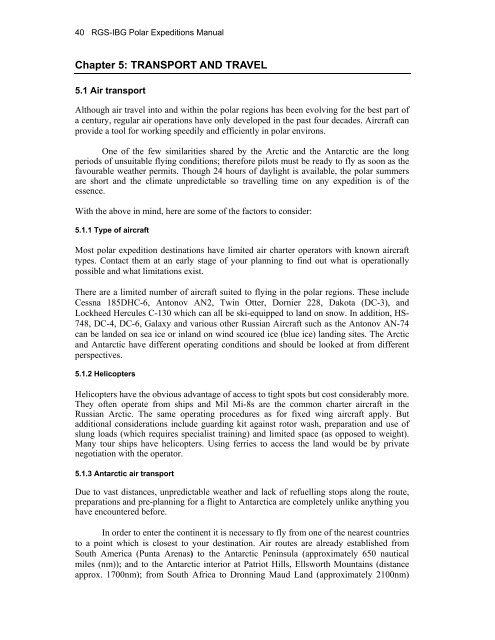Edited by Rachel Duncan 4th Edition ISBN 0-907649-91-2 London ...
Edited by Rachel Duncan 4th Edition ISBN 0-907649-91-2 London ...
Edited by Rachel Duncan 4th Edition ISBN 0-907649-91-2 London ...
Create successful ePaper yourself
Turn your PDF publications into a flip-book with our unique Google optimized e-Paper software.
40 RGS-IBG Polar Expeditions Manual<br />
Chapter 5: TRANSPORT AND TRAVEL<br />
5.1 Air transport<br />
Although air travel into and within the polar regions has been evolving for the best part of<br />
a century, regular air operations have only developed in the past four decades. Aircraft can<br />
provide a tool for working speedily and efficiently in polar environs.<br />
One of the few similarities shared <strong>by</strong> the Arctic and the Antarctic are the long<br />
periods of unsuitable flying conditions; therefore pilots must be ready to fly as soon as the<br />
favourable weather permits. Though 24 hours of daylight is available, the polar summers<br />
are short and the climate unpredictable so travelling time on any expedition is of the<br />
essence.<br />
With the above in mind, here are some of the factors to consider:<br />
5.1.1 Type of aircraft<br />
Most polar expedition destinations have limited air charter operators with known aircraft<br />
types. Contact them at an early stage of your planning to find out what is operationally<br />
possible and what limitations exist.<br />
There are a limited number of aircraft suited to flying in the polar regions. These include<br />
Cessna 185DHC-6, Antonov AN2, Twin Otter, Dornier 228, Dakota (DC-3), and<br />
Lockheed Hercules C-130 which can all be ski-equipped to land on snow. In addition, HS-<br />
748, DC-4, DC-6, Galaxy and various other Russian Aircraft such as the Antonov AN-74<br />
can be landed on sea ice or inland on wind scoured ice (blue ice) landing sites. The Arctic<br />
and Antarctic have different operating conditions and should be looked at from different<br />
perspectives.<br />
5.1.2 Helicopters<br />
Helicopters have the obvious advantage of access to tight spots but cost considerably more.<br />
They often operate from ships and Mil Mi-8s are the common charter aircraft in the<br />
Russian Arctic. The same operating procedures as for fixed wing aircraft apply. But<br />
additional considerations include guarding kit against rotor wash, preparation and use of<br />
slung loads (which requires specialist training) and limited space (as opposed to weight).<br />
Many tour ships have helicopters. Using ferries to access the land would be <strong>by</strong> private<br />
negotiation with the operator.<br />
5.1.3 Antarctic air transport<br />
Due to vast distances, unpredictable weather and lack of refuelling stops along the route,<br />
preparations and pre-planning for a flight to Antarctica are completely unlike anything you<br />
have encountered before.<br />
In order to enter the continent it is necessary to fly from one of the nearest countries<br />
to a point which is closest to your destination. Air routes are already established from<br />
South America (Punta Arenas) to the Antarctic Peninsula (approximately 650 nautical<br />
miles (nm)); and to the Antarctic interior at Patriot Hills, Ellsworth Mountains (distance<br />
approx. 1700nm); from South Africa to Dronning Maud Land (approximately 2100nm)

















